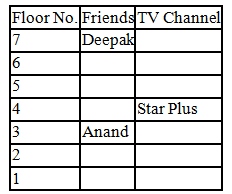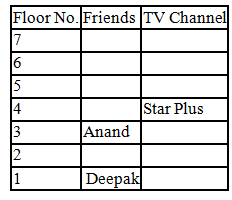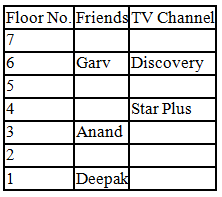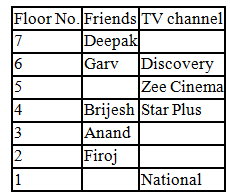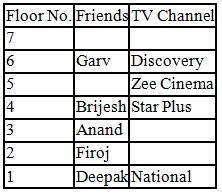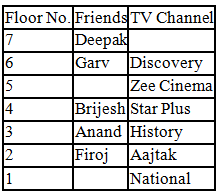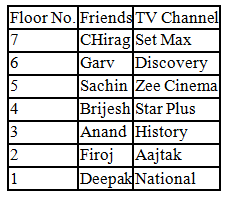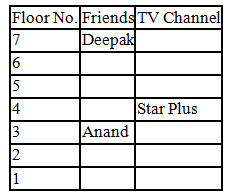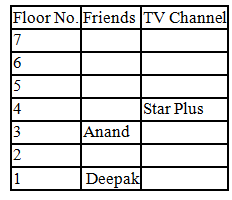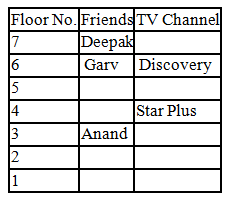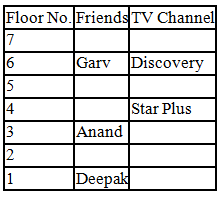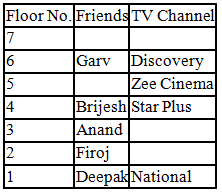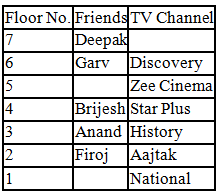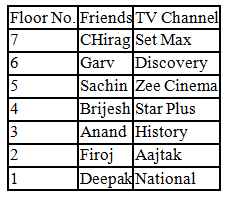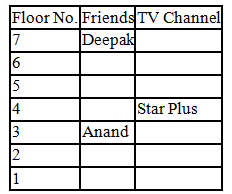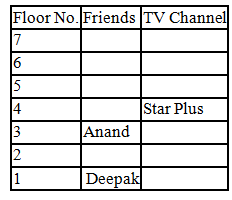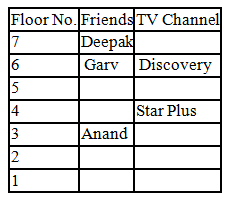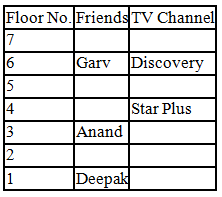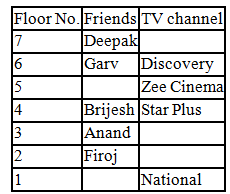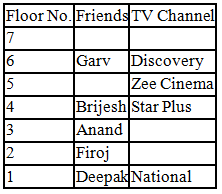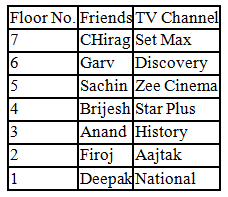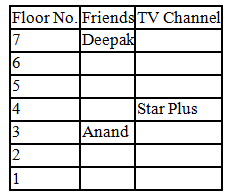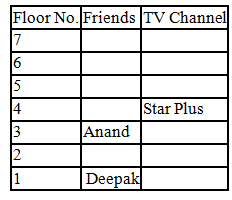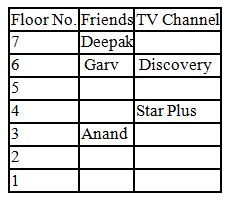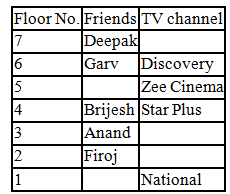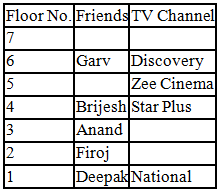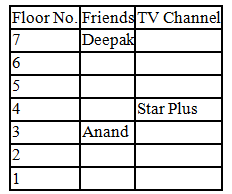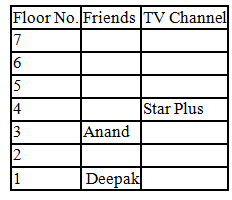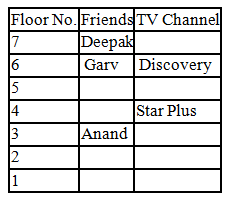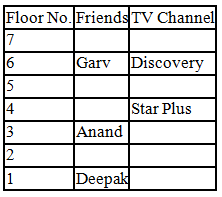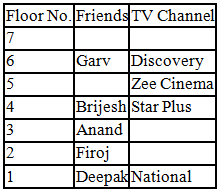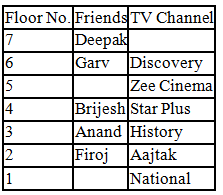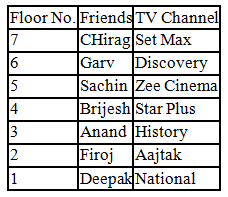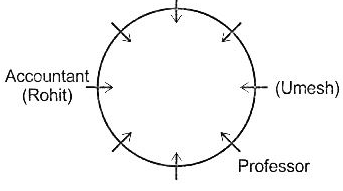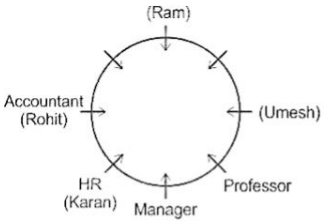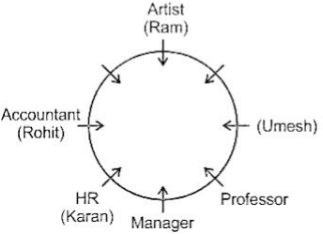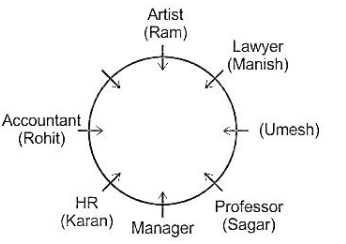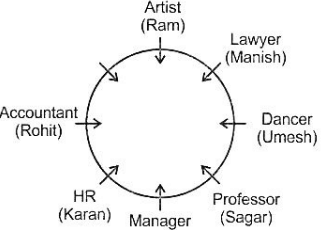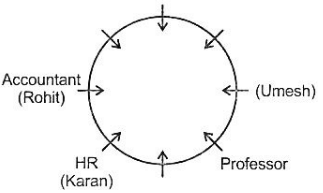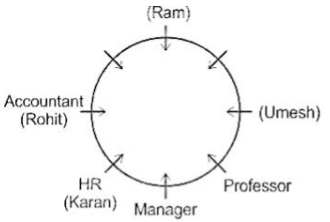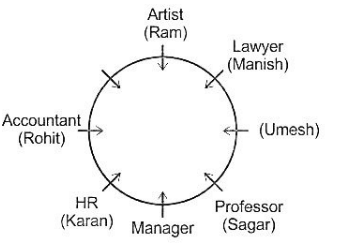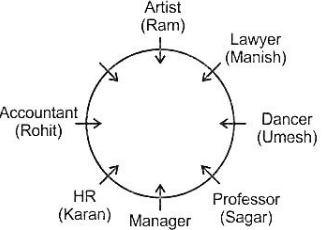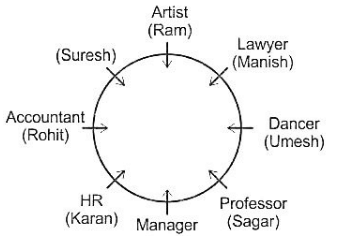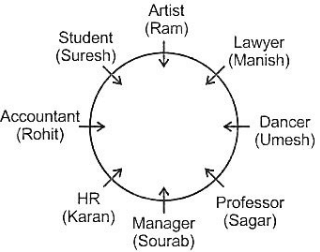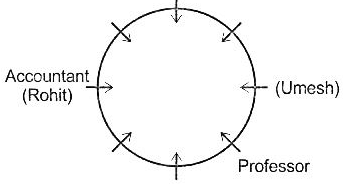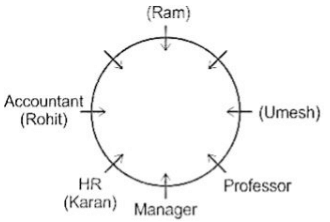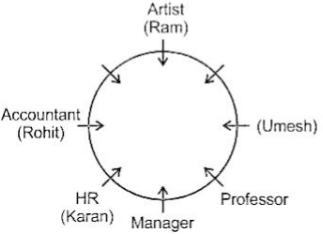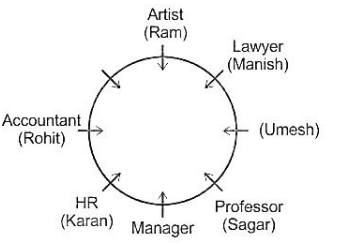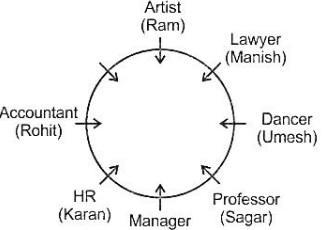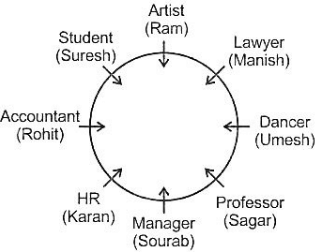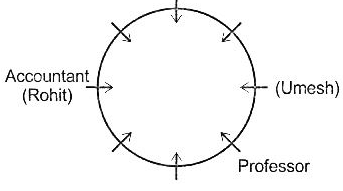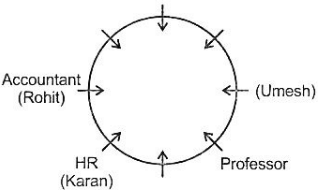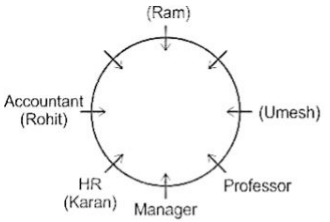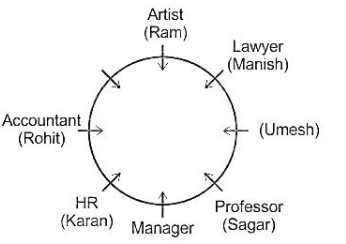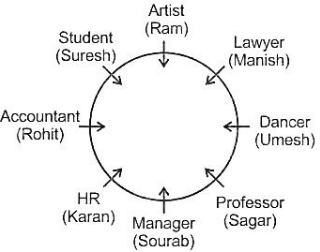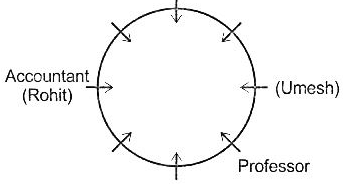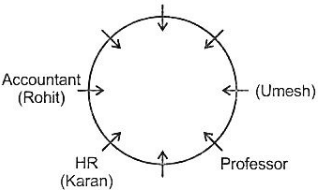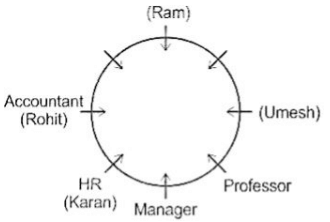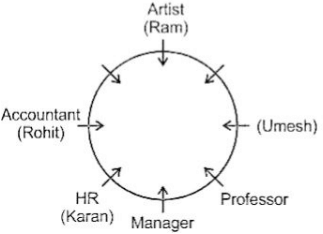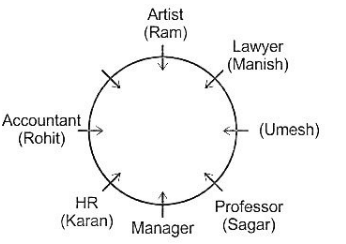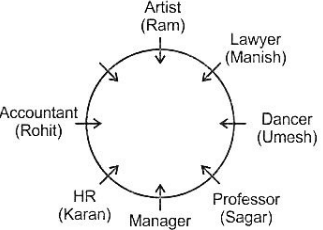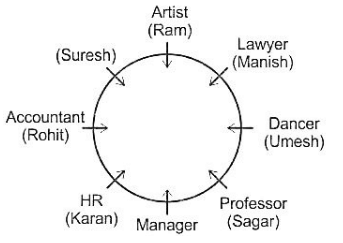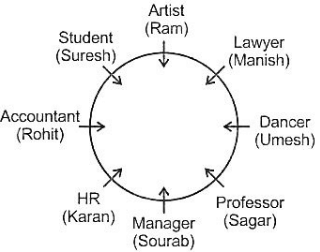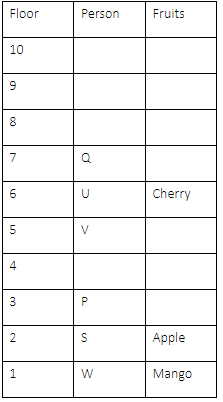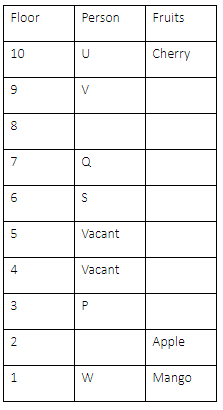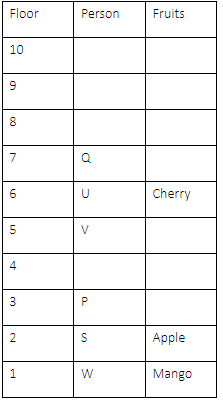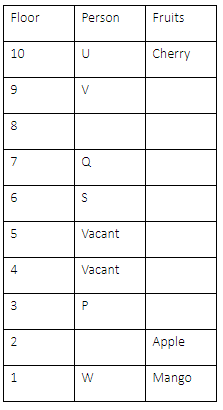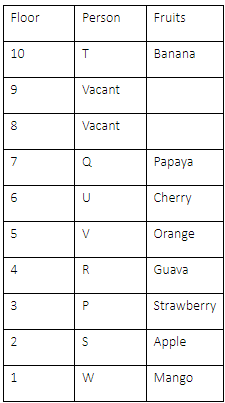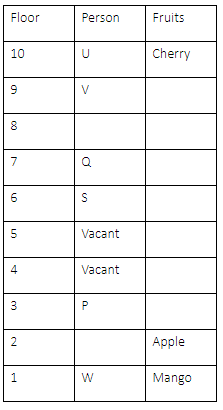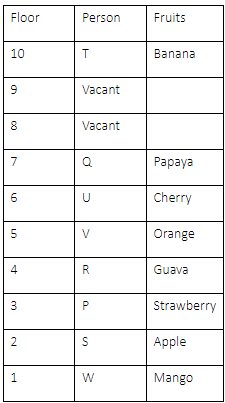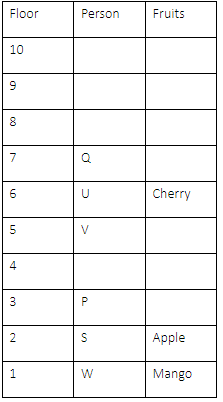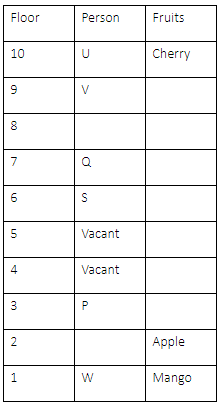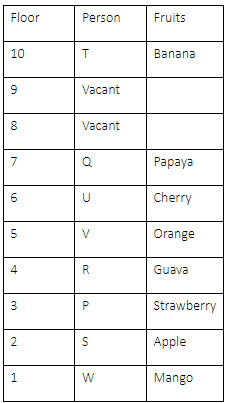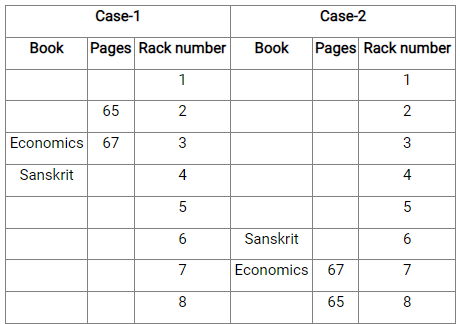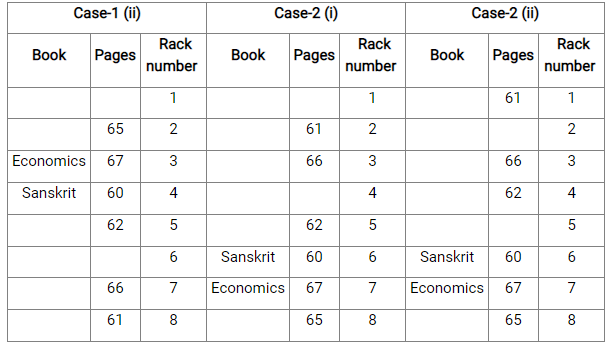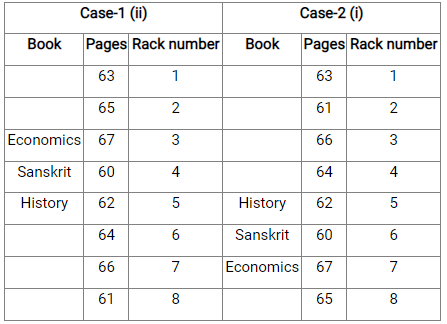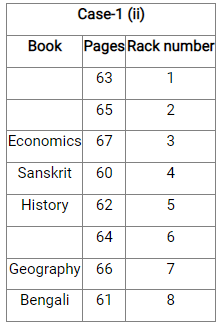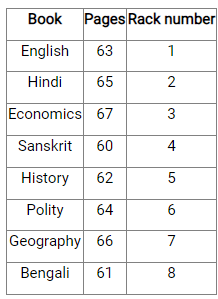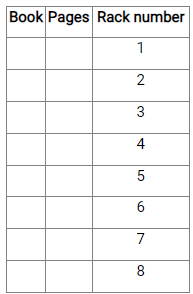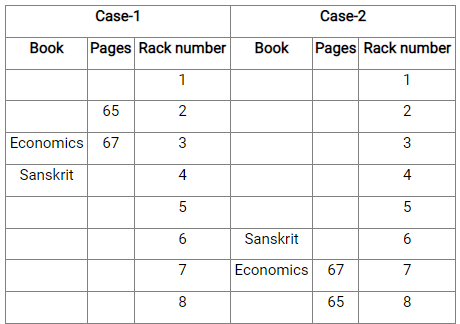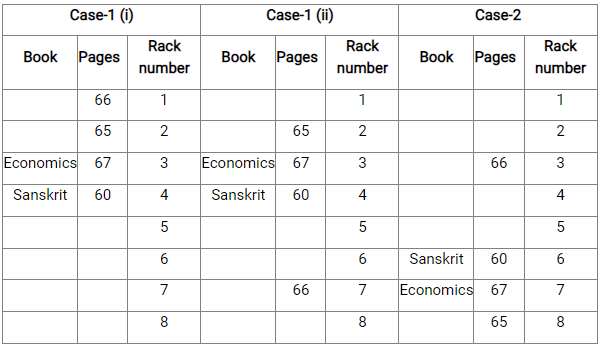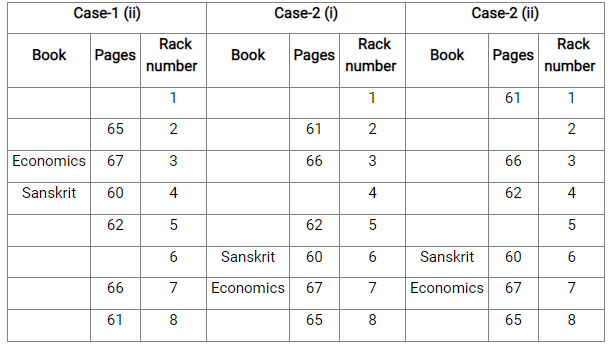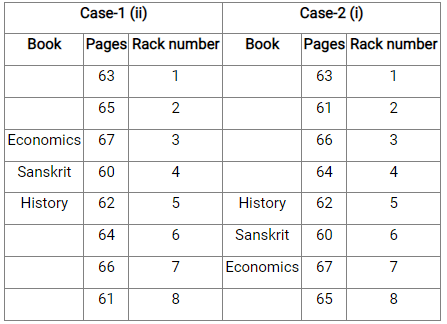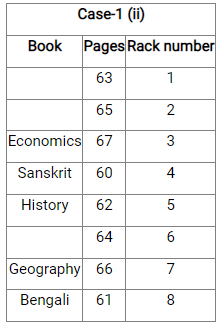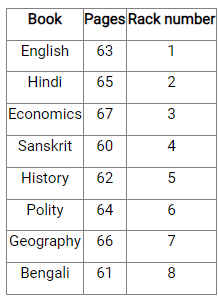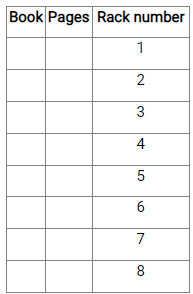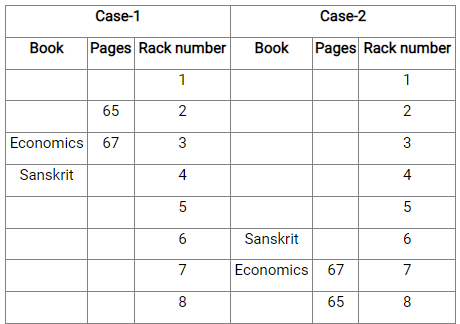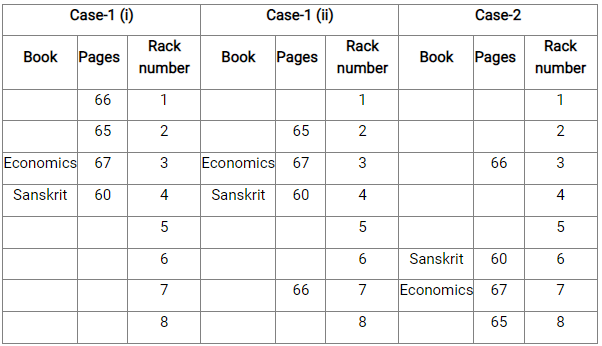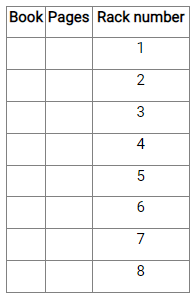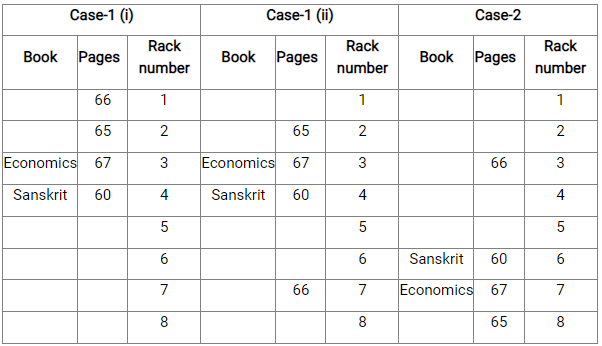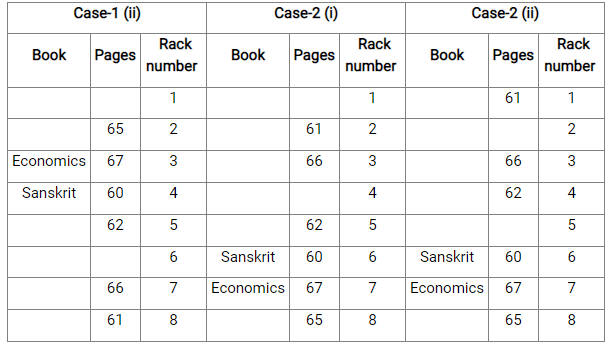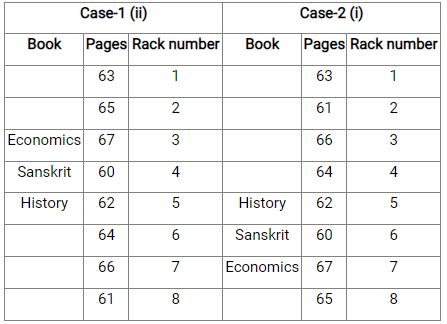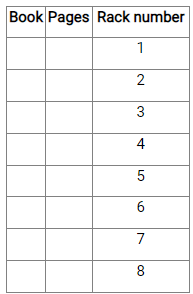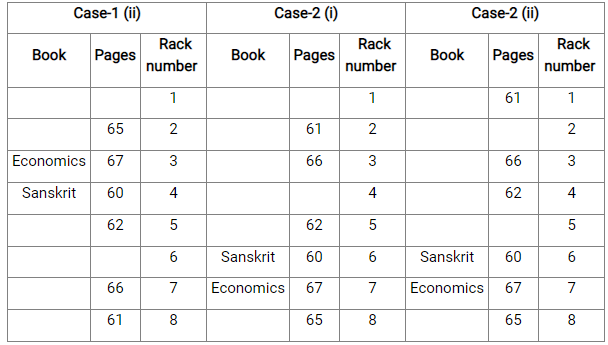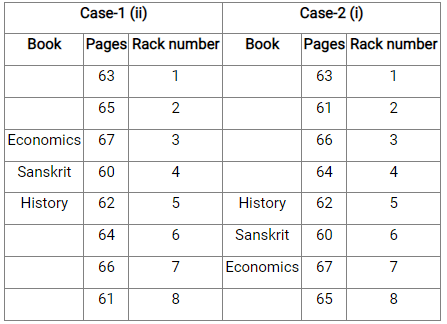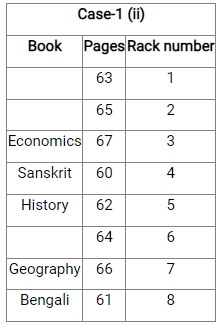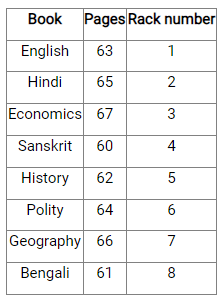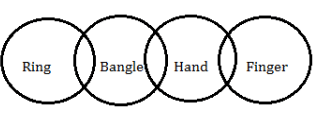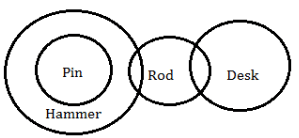IBPS RRB PO (Scale 1) Mains Mock Test - 10 - Bank Exams MCQ
30 Questions MCQ Test - IBPS RRB PO (Scale 1) Mains Mock Test - 10
Read the following information carefully and answer the question given below-
Anand, Brijesh, Chirag, Deepak, Sachin, Firoj and Garv are seven friends who live in a building of seven floors. They live on separate floors of a same seven storey building, but not in the same order. The ground floor of the building is numbered 1, the floor above it 2 and so on until the topmost floor is numbered 7. Each person likes different TV channel viz, Zee Cinema, Set Max, National, Star Plus, History, AajTak and Discovery, but not necessarily in the same order.
The person who likes Star Plus lives on floor numbered 4. Only two persons live between Deepak and the one who likes Star Plus. Anand does not live on the lowermost floor. Anand lives on any odd-numbered floor below the one who likes Star Plus. Garv lives on an even numbered floor but neither immediately above nor immediately below the floor of Anand. Only two persons live between Anand and the person who likes Discovery. Only one person lives between Brijesh and Firoj. Firoj lives on an even numbered floor and does not like Star Plus. Only three persons live between the persons who like Zee Cinema and National respectively. The person who likes Zee Cinema lives on any floor above the Brijesh’s floor. The person who likes Zee Cinema does not live on the topmost floor. Chirag does not like Zee Cinema or National. The person who likes History lives on the floor immediately above the floor of the person who likes AajTak.
Q. Who among the following lives exactly between the floors on which Garv and Brijesh live?
Read the following information carefully and answer the question given below-
Anand, Brijesh, Chirag, Deepak, Sachin, Firoj and Garv are seven friends who live in a building of seven floors. They live on separate floors of a same seven storey building, but not in the same order. The ground floor of the building is numbered 1, the floor above it 2 and so on until the topmost floor is numbered 7. Each person likes different TV channel viz, Zee Cinema, Set Max, National, Star Plus, History, AajTak and Discovery, but not necessarily in the same order.
The person who likes Star Plus lives on floor numbered 4. Only two persons live between Deepak and the one who likes Star Plus. Anand does not live on the lowermost floor. Anand lives on any odd-numbered floor below the one who likes Star Plus. Garv lives on an even numbered floor but neither immediately above nor immediately below the floor of Anand. Only two persons live between Anand and the person who likes Discovery. Only one person lives between Brijesh and Firoj. Firoj lives on an even numbered floor and does not like Star Plus. Only three persons live between the persons who like Zee Cinema and National respectively. The person who likes Zee Cinema lives on any floor above the Brijesh’s floor. The person who likes Zee Cinema does not live on the topmost floor. Chirag does not like Zee Cinema or National. The person who likes History lives on the floor immediately above the floor of the person who likes AajTak.
Q. Which of the following statements is/are true according to the given information?
Read the following information carefully and answer the question given below-
Anand, Brijesh, Chirag, Deepak, Sachin, Firoj and Garv are seven friends who live in a building of seven floors. They live on separate floors of a same seven storey building, but not in the same order. The ground floor of the building is numbered 1, the floor above it 2 and so on until the topmost floor is numbered 7. Each person likes different TV channel viz, Zee Cinema, Set Max, National, Star Plus, History, AajTak and Discovery, but not necessarily in the same order.
The person who likes Star Plus lives on floor numbered 4. Only two persons live between Deepak and the one who likes Star Plus. Anand does not live on the lowermost floor. Anand lives on any odd-numbered floor below the one who likes Star Plus. Garv lives on an even numbered floor but neither immediately above nor immediately below the floor of Anand. Only two persons live between Anand and the person who likes Discovery. Only one person lives between Brijesh and Firoj. Firoj lives on an even numbered floor and does not like Star Plus. Only three persons live between the persons who like Zee Cinema and National respectively. The person who likes Zee Cinema lives on any floor above the Brijesh’s floor. The person who likes Zee Cinema does not live on the topmost floor. Chirag does not like Zee Cinema or National. The person who likes History lives on the floor immediately above the floor of the person who likes AajTak.
Q. Who among the following does like National?
Read the following information carefully and answer the question given below-
Anand, Brijesh, Chirag, Deepak, Sachin, Firoj and Garv are seven friends who live in a building of seven floors. They live on separate floors of a same seven storey building, but not in the same order. The ground floor of the building is numbered 1, the floor above it 2 and so on until the topmost floor is numbered 7. Each person likes different TV channel viz, Zee Cinema, Set Max, National, Star Plus, History, AajTak and Discovery, but not necessarily in the same order.
The person who likes Star Plus lives on floor numbered 4. Only two persons live between Deepak and the one who likes Star Plus. Anand does not live on the lowermost floor. Anand lives on any odd-numbered floor below the one who likes Star Plus. Garv lives on an even numbered floor but neither immediately above nor immediately below the floor of Anand. Only two persons live between Anand and the person who likes Discovery. Only one person lives between Brijesh and Firoj. Firoj lives on an even numbered floor and does not like Star Plus. Only three persons live between the persons who like Zee Cinema and National respectively. The person who likes Zee Cinema lives on any floor above the Brijesh’s floor. The person who likes Zee Cinema does not live on the topmost floor. Chirag does not like Zee Cinema or National. The person who likes History lives on the floor immediately above the floor of the person who likes AajTak.
Q. Who among the following lives on the floor immediately above the floor of Anand?
Read the following information carefully and answer the question given below-
Anand, Brijesh, Chirag, Deepak, Sachin, Firoj and Garv are seven friends who live in a building of seven floors. They live on separate floors of a same seven storey building, but not in the same order. The ground floor of the building is numbered 1, the floor above it 2 and so on until the topmost floor is numbered 7. Each person likes different TV channel viz, Zee Cinema, Set Max, National, Star Plus, History, AajTak and Discovery, but not necessarily in the same order.
The person who likes Star Plus lives on floor numbered 4. Only two persons live between Deepak and the one who likes Star Plus. Anand does not live on the lowermost floor. Anand lives on any odd-numbered floor below the one who likes Star Plus. Garv lives on an even numbered floor but neither immediately above nor immediately below the floor of Anand. Only two persons live between Anand and the person who likes Discovery. Only one person lives between Brijesh and Firoj. Firoj lives on an even numbered floor and does not like Star Plus. Only three persons live between the persons who like Zee Cinema and National respectively. The person who likes Zee Cinema lives on any floor above the Brijesh’s floor. The person who likes Zee Cinema does not live on the topmost floor. Chirag does not like Zee Cinema or National. The person who likes History lives on the floor immediately above the floor of the person who likes AajTak.
How many persons live between the floors on which Garv and Deepak live?
Direction: Study the following information and answer the given questions.
Eight friends Ram, Rohit, Karan, Sagar, Sourab, Manish, Suresh and Umesh are sitting in a circle facing the center. All eight friends belong to different professions – HR, Professor, Lawyer, Student, Accountant, Manager, Dancer and Artist. They are not necessarily seated in the mentioned order. Accountant sits third to the left of Professor. Manish who is a lawyer sits second to the left of person who sits opposite of Sagar. Sagar is either Professor or Student. Karan who is HR sits immediate right of Rohit. Three persons sits between Manager and Ram. The manager sits between HR and Professor. Umesh sits fourth to the right of Rohit who is an Accountant. Ram is not the Professor. Two persons sit between Professor and Artist. Sagar sits third to the left of Ram. There is one person sitting between artist and Dancer. Suresh sits third to the left of the Manager. More than one person sits between Ram and Professor.
Q. What is Suresh's profession?
Direction: Study the following information and answer the given questions.
Eight friends Ram, Rohit, Karan, Sagar, Sourab, Manish, Suresh and Umesh are sitting in a circle facing the center. All eight friends belong to different professions – HR, Professor, Lawyer, Student, Accountant, Manager, Dancer and Artist. They are not necessarily seated in the mentioned order. Accountant sits third to the left of Professor. Manish who is a lawyer sits second to the left of person who sits opposite of Sagar. Sagar is either Professor or Student. Karan who is HR sits immediate right of Rohit. Three persons sits between Manager and Ram. The manager sits between HR and Professor. Umesh sits fourth to the right of Rohit who is an Accountant. Ram is not the Professor. Two persons sit between Professor and Artist. Sagar sits third to the left of Ram. There is one person sitting between artist and Dancer. Suresh sits third to the left of the Manager. More than one person sits between Ram and Professor.
Q. Who is manager?
Direction: Study the following information and answer the given questions.
Eight friends Ram, Rohit, Karan, Sagar, Sourab, Manish, Suresh and Umesh are sitting in a circle facing the center. All eight friends belong to different professions – HR, Professor, Lawyer, Student, Accountant, Manager, Dancer and Artist. They are not necessarily seated in the mentioned order. Accountant sits third to the left of Professor. Manish who is a lawyer sits second to the left of person who sits opposite of Sagar. Sagar is either Professor or Student. Karan who is HR sits immediate right of Rohit. Three persons sits between Manager and Ram. The manager sits between HR and Professor. Umesh sits fourth to the right of Rohit who is an Accountant. Ram is not the Professor. Two persons sit between Professor and Artist. Sagar sits third to the left of Ram. There is one person sitting between artist and Dancer. Suresh sits third to the left of the Manager. More than one person sits between Ram and Professor.
Q. Who sits second to the left of person whose profession is Artist?
Direction: Study the following information and answer the given questions.
Eight friends Ram, Rohit, Karan, Sagar, Sourab, Manish, Suresh and Umesh are sitting in a circle facing the center. All eight friends belong to different professions – HR, Professor, Lawyer, Student, Accountant, Manager, Dancer and Artist. They are not necessarily seated in the mentioned order. Accountant sits third to the left of Professor. Manish who is a lawyer sits second to the left of person who sits opposite of Sagar. Sagar is either Professor or Student. Karan who is HR sits immediate right of Rohit. Three persons sits between Manager and Ram. The manager sits between HR and Professor. Umesh sits fourth to the right of Rohit who is an Accountant. Ram is not the Professor. Two persons sit between Professor and Artist. Sagar sits third to the left of Ram. There is one person sitting between artist and Dancer. Suresh sits third to the left of the Manager. More than one person sits between Ram and Professor.
Q. Who is sitting opposite to HR?
Direction: Study the following information and answer the given questions.
Eight friends Ram, Rohit, Karan, Sagar, Sourab, Manish, Suresh and Umesh are sitting in a circle facing the center. All eight friends belong to different professions – HR, Professor, Lawyer, Student, Accountant, Manager, Dancer and Artist. They are not necessarily seated in the mentioned order. Accountant sits third to the left of Professor. Manish who is a lawyer sits second to the left of person who sits opposite of Sagar. Sagar is either Professor or Student. Karan who is HR sits immediate right of Rohit. Three persons sits between Manager and Ram. The manager sits between HR and Professor. Umesh sits fourth to the right of Rohit who is an Accountant. Ram is not the Professor. Two persons sit between Professor and Artist. Sagar sits third to the left of Ram. There is one person sitting between artist and Dancer. Suresh sits third to the left of the Manager. More than one person sits between Ram and Professor.
Q. Who is Professor?
Study the following information to answer the given questions:
A, B, C, D, E, F, and G are seated in a straight line facing North but not necessarily in the same order. Only three people sit between F and A. Neither F nor A sits at an extreme end of the line. Only two people sit between A and G. E is not an immediate neighbour of either A or F. E sits third to the left of B. B is not an immediate neighbour of A. E is not an immediate neighbour of C.
Q. Which of the following pairs represents persons seated at the two extreme ends of the line?
Study the following information to answer the given questions:
A, B, C, D, E, F, and G are seated in a straight line facing North but not necessarily in the same order. Only three people sit between F and A. Neither F nor A sits at an extreme end of the line. Only two people sit between A and G. E is not an immediate neighbour of either A or F. E sits third to the left of B. B is not an immediate neighbour of A. E is not an immediate neighbour of C.
Q. How many persons are seated between B and A?
Study the following information to answer the given questions:
A, B, C, D, E, F, and G are seated in a straight line facing North but not necessarily in the same order. Only three people sit between F and A. Neither F nor A sits at an extreme end of the line. Only two people sit between A and G. E is not an immediate neighbour of either A or F. E sits third to the left of B. B is not an immediate neighbour of A. E is not an immediate neighbour of C.
Q. Who amongst the following sit exactly between A and G?
Study the following information to answer the given questions:
A, B, C, D, E, F, and G are seated in a straight line facing North but not necessarily in the same order. Only three people sit between F and A. Neither F nor A sits at an extreme end of the line. Only two people sit between A and G. E is not an immediate neighbour of either A or F. E sits third to the left of B. B is not an immediate neighbour of A. E is not an immediate neighbour of C.
Q. What is the position of E with respect to C?
Study the following information to answer the given questions:
A, B, C, D, E, F, and G are seated in a straight line facing North but not necessarily in the same order. Only three people sit between F and A. Neither F nor A sits at an extreme end of the line. Only two people sit between A and G. E is not an immediate neighbour of either A or F. E sits third to the left of B. B is not an immediate neighbour of A. E is not an immediate neighbour of C.
Q. Which of the following is true with respect to the given arrangement?
Direction: Study the following information carefully and answer the questions given below.
A number arrangement machine, when given an input, rearranges it following a particular rule. The following is the illustration of the input and the steps of arrangement.
Input: cool world found house emergency segment repeated
Step 1: repeated cool world found house emergency segment
Step 2: repeated world cool found house emergency segment
Step 3: repeated world found cool house emergency segment
Step 4: repeated world found house cool emergency segment
Step 5: repeated world found house cool segment emergency
Step 6: 4O 1Q 2T 3T 2N 2F 3D
Step 7: K P R Q L D A
Step 8: A D K L P Q R
Step 8 is the last step of the rearrangement.
As per the rules followed in the above steps, find out in each of the following questions.
Input: out special separated constituency follower different rhythm
Q. Which of the following is the third element from the right end in step 4?
Direction: Study the following information carefully and answer the questions given below.
A number arrangement machine, when given an input, rearranges it following a particular rule. The following is the illustration of the input and the steps of arrangement.
Input: cool world found house emergency segment repeated
Step 1: repeated cool world found house emergency segment
Step 2: repeated world cool found house emergency segment
Step 3: repeated world found cool house emergency segment
Step 4: repeated world found house cool emergency segment
Step 5: repeated world found house cool segment emergency
Step 6: 4O 1Q 2T 3T 2N 2F 3D
Step 7: K P R Q L D A
Step 8: A D K L P Q R
Step 8 is the last step of the rearrangement.
As per the rules followed in the above steps, find out in each of the following questions.
Input: out special separated constituency follower different rhythm
Q. Which of the following element is immediately left of 3K in Step 6?
Direction: Study the following information carefully and answer the questions given below.
A number arrangement machine, when given an input, rearranges it following a particular rule. The following is the illustration of the input and the steps of arrangement.
Input: cool world found house emergency segment repeated
Step 1: repeated cool world found house emergency segment
Step 2: repeated world cool found house emergency segment
Step 3: repeated world found cool house emergency segment
Step 4: repeated world found house cool emergency segment
Step 5: repeated world found house cool segment emergency
Step 6: 4O 1Q 2T 3T 2N 2F 3D
Step 7: K P R Q L D A
Step 8: A D K L P Q R
Step 8 is the last step of the rearrangement.
As per the rules followed in the above steps, find out in each of the following questions.
Input: out special separated constituency follower different rhythm
Q. Which of the following is Step 7 for the given input?
Direction: Study the following information carefully and answer the questions given below.
A number arrangement machine, when given an input, rearranges it following a particular rule. The following is the illustration of the input and the steps of arrangement.
Input: cool world found house emergency segment repeated
Step 1: repeated cool world found house emergency segment
Step 2: repeated world cool found house emergency segment
Step 3: repeated world found cool house emergency segment
Step 4: repeated world found house cool emergency segment
Step 5: repeated world found house cool segment emergency
Step 6: 4O 1Q 2T 3T 2N 2F 3D
Step 7: K P R Q L D A
Step 8: A D K L P Q R
Step 8 is the last step of the rearrangement.
As per the rules followed in the above steps, find out in each of the following questions.
Input: out special separated constituency follower different rhythm
Q. In step 3, which element is fourth to the right of third element from the left end?
Direction: Read the following information carefully and answer the questions given below it.
Eight person P, Q, R, S, T, U, V and W lives on ten floors building starting from ground floor number one to top floor number ten. There were two consecutive vacant floors in the building. There are eight fruits Apple, Banana, Papaya, Orange, Cherry, Strawberry and Guava in which only one person likes one fruit, but not necessarily in the same order. The one who likes Guava lives below the one who likes papaya but he does not live below the one who likes strawberry. There are three floors between P and Q. The person who likes mango lives below to both P and Q. There are only two floor between U and the one likes Banana. U lives one of the floors below to the one who likes Banana, There are only three floors between U and S. V lives immediately below U. V lives immediately below one who likes cherry. The number of person live between U and the one who likes banana is same as the number of person between U and the person who likes orange. S does not like Banana. The one who likes cherry does not lives on the topmost floors. There are two floors between W and R. The one who likes Apple lives immediately between P and W. W likes Mango and lives on bottom most floor. Q lives above P.
Q. Who among the following likes Papaya?
Direction: Read the following information carefully and answer the questions given below it.
Eight person P, Q, R, S, T, U, V and W lives on ten floors building starting from ground floor number one to top floor number ten. There were two consecutive vacant floors in the building. There are eight fruits Apple, Banana, Papaya, Orange, Cherry, Strawberry and Guava in which only one person likes one fruit, but not necessarily in the same order. The one who likes Guava lives below the one who likes papaya but he does not live below the one who likes strawberry. There are three floors between P and Q. The person who likes mango lives below to both P and Q. There are only two floor between U and the one likes Banana. U lives one of the floors below to the one who likes Banana, There are only three floors between U and S. V lives immediately below U. V lives immediately below one who likes cherry. The number of person live between U and the one who likes banana is same as the number of person between U and the person who likes orange. S does not like Banana. The one who likes cherry does not lives on the topmost floors. There are two floors between W and R. The one who likes Apple lives immediately between P and W. W likes Mango and lives on bottom most floor. Q lives above P.
Q. Which of the following is a vacant floor?
Direction: Read the following information carefully and answer the questions given below it.
Eight person P, Q, R, S, T, U, V and W lives on ten floors building starting from ground floor number one to top floor number ten. There were two consecutive vacant floors in the building. There are eight fruits Apple, Banana, Papaya, Orange, Cherry, Strawberry and Guava in which only one person likes one fruit, but not necessarily in the same order. The one who likes Guava lives below the one who likes papaya but he does not live below the one who likes strawberry. There are three floors between P and Q. The person who likes mango lives below to both P and Q. There are only two floor between U and the one likes Banana. U lives one of the floors below to the one who likes Banana, There are only three floors between U and S. V lives immediately below U. V lives immediately below one who likes cherry. The number of person live between U and the one who likes banana is same as the number of person between U and the person who likes orange. S does not like Banana. The one who likes cherry does not lives on the topmost floors. There are two floors between W and R. The one who likes Apple lives immediately between P and W. W likes Mango and lives on bottom most floor. Q lives above P.
Q. Who among the following lives immediately above the vacant floor?
Direction: Read the following information carefully and answer the questions given below it.
Eight person P, Q, R, S, T, U, V and W lives on ten floors building starting from ground floor number one to top floor number ten. There were two consecutive vacant floors in the building. There are eight fruits Apple, Banana, Papaya, Orange, Cherry, Strawberry and Guava in which only one person likes one fruit, but not necessarily in the same order. The one who likes Guava lives below the one who likes papaya but he does not live below the one who likes strawberry. There are three floors between P and Q. The person who likes mango lives below to both P and Q. There are only two floor between U and the one likes Banana. U lives one of the floors below to the one who likes Banana, There are only three floors between U and S. V lives immediately below U. V lives immediately below one who likes cherry. The number of person live between U and the one who likes banana is same as the number of person between U and the person who likes orange. S does not like Banana. The one who likes cherry does not lives on the topmost floors. There are two floors between W and R. The one who likes Apple lives immediately between P and W. W likes Mango and lives on bottom most floor. Q lives above P.
Q. How many persons live between T and the one who likes Gauva?
Direction: Study the given information carefully and answer the following question below.
Eight books History, English, Hindi, Geography, Sanskrit, Polity, Economics and Bengali are kept in 8 different racks of an Almirah. Each book has a different number of pages viz. 60, 61, 62, 63, 64, 65, 66 and 67 but not necessarily in that order. Racks are arranged in a way that one rack is above or below to another rack and books are not arranged in the racks in that specific order. Numbers are given to each rack in such a way that uppermost rack numbered 1 and lowermost rack numbered 8.
Geography book is not kept next to either Hindi or English. Economics, which has 67 pages, is kept between Sanskrit book and a book of 65 pages. Bengali is kept below History. Bengali does not have 66 pages. History does not have 61 pages. There are two books between a 61 pages book and a 62 pages book. The book, which has 64 pages, is kept between History and a book, which has 66 pages. Bengali is placed immediately below to Geography. The 65 pages book is kept in an even-numbered rack but neither in the 4th number nor in 6th number. There are two books between Sanskrit and the book which has 66 pages. Hindi does not have 63 pages. There is no book between a 67 pages book and a 60 pages book. 62 pages book is between the 60 pages book and 66 pages book but not exactly between them.
Q. Select the pair which has the wrong combination of book name and page number of that book.
Direction: Study the given information carefully and answer the following question below.
Eight books History, English, Hindi, Geography, Sanskrit, Polity, Economics and Bengali are kept in 8 different racks of an Almirah. Each book has a different number of pages viz. 60, 61, 62, 63, 64, 65, 66 and 67 but not necessarily in that order. Racks are arranged in a way that one rack is above or below to another rack and books are not arranged in the racks in that specific order. Numbers are given to each rack in such a way that uppermost rack numbered 1 and lowermost rack numbered 8.Geography book is not kept next to either Hindi or English. Economics, which has 67 pages, is kept between Sanskrit book and a book of 65 pages. Bengali is kept below History. Bengali does not have 66 pages. History does not have 61 pages. There are two books between a 61 pages book and a 62 pages book. The book, which has 64 pages, is kept between History and a book, which has 66 pages. Bengali is placed immediately below to Geography. The 65 pages book is kept in an even-numbered rack but neither in the 4th number nor in 6th number. There are two books between Sanskrit and the book which has 66 pages. Hindi does not have 63 pages. There is no book between a 67 pages book and a 60 pages book. 62 pages book is between the 60 pages book and 66 pages book but not exactly between them.
Q. Which book has the maximum number of pages?
Direction: Study the given information carefully and answer the following question below.
Eight books History, English, Hindi, Geography, Sanskrit, Polity, Economics and Bengali are kept in 8 different racks of an Almirah. Each book has a different number of pages viz. 60, 61, 62, 63, 64, 65, 66 and 67 but not necessarily in that order. Racks are arranged in a way that one rack is above or below to another rack and books are not arranged in the racks in that specific order. Numbers are given to each rack in such a way that uppermost rack numbered 1 and lowermost rack numbered 8. Geography book is not kept next to either Hindi or English. Economics, which has 67 pages, is kept between Sanskrit book and a book of 65 pages. Bengali is kept below History. Bengali does not have 66 pages. History does not have 61 pages. There are two books between a 61 pages book and a 62 pages book. The book, which has 64 pages, is kept between History and a book, which has 66 pages. Bengali is placed immediately below to Geography. The 65 pages book is kept in an even-numbered rack but neither in the 4th number nor in 6th number. There are two books between Sanskrit and the book which has 66 pages. Hindi does not have 63 pages. There is no book between a 67 pages book and a 60 pages book. 62 pages book is between the 60 pages book and 66 pages book but not exactly between them.
Q. Which pair of books has only two books between them?
Direction: Study the given information carefully and answer the following question below.
Eight books History, English, Hindi, Geography, Sanskrit, Polity, Economics and Bengali are kept in 8 different racks of an Almirah. Each book has a different number of pages viz. 60, 61, 62, 63, 64, 65, 66 and 67 but not necessarily in that order. Racks are arranged in a way that one rack is above or below to another rack and books are not arranged in the racks in that specific order. Numbers are given to each rack in such a way that uppermost rack numbered 1 and lowermost rack numbered 8. Geography book is not kept next to either Hindi or English. Economics, which has 67 pages, is kept between Sanskrit book and a book of 65 pages. Bengali is kept below History. Bengali does not have 66 pages. History does not have 61 pages. There are two books between a 61 pages book and a 62 pages book. The book, which has 64 pages, is kept between History and a book, which has 66 pages. Bengali is placed immediately below to Geography. The 65 pages book is kept in an even-numbered rack but neither in the 4th number nor in 6th number. There are two books between Sanskrit and the book which has 66 pages. Hindi does not have 63 pages. There is no book between a 67 pages book and a 60 pages book. 62 pages book is between the 60 pages book and 66 pages book but not exactly between them.
Q. What is rack number of the Polity book?
Direction: Study the given information carefully and answer the following question below.
Eight books History, English, Hindi, Geography, Sanskrit, Polity, Economics and Bengali are kept in 8 different racks of an Almirah. Each book has a different number of pages viz. 60, 61, 62, 63, 64, 65, 66 and 67 but not necessarily in that order. Racks are arranged in a way that one rack is above or below to another rack and books are not arranged in the racks in that specific order. Numbers are given to each rack in such a way that uppermost rack numbered 1 and lowermost rack numbered 8. Geography book is not kept next to either Hindi or English. Economics, which has 67 pages, is kept between Sanskrit book and a book of 65 pages. Bengali is kept below History. Bengali does not have 66 pages. History does not have 61 pages. There are two books between a 61 pages book and a 62 pages book. The book, which has 64 pages, is kept between History and a book, which has 66 pages. Bengali is placed immediately below to Geography. The 65 pages book is kept in an even-numbered rack but neither in the 4th number nor in 6th number. There are two books between Sanskrit and the book which has 66 pages. Hindi does not have 63 pages. There is no book between a 67 pages book and a 60 pages book. 62 pages book is between the 60 pages book and 66 pages book but not exactly between them.
Q. How many pages are there in the book Bengali?
In each question below are three statements followed by two conclusions numbered I and II. You have to take the three given statements to be true even it seems to be a variance from commonly known facts. Read all the conclusions and then decide which of the given conclusions logically follows from the given statements disregarding commonly known facts.
Statements:
Some rings are bangles.
Some bangles are hands.
Some hands are fingers.
Conclusions:
Some fingers are bangles.
Some hands are rings.
In each question below are three statements followed by two conclusions numbered I and II. You have to take the three given statements to be true even it seems to be a variance from commonly known facts. Read all the conclusions and then decide which of the given conclusions logically follows from the given statements disregarding commonly known facts.
Statements:
All pins are hammers.
Some hammers are rods.
Some rods are desks.
Conclusions:
Some desks are pins.
Some rods are hammers.


